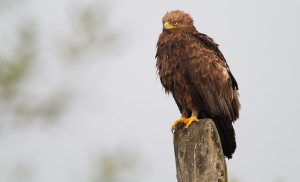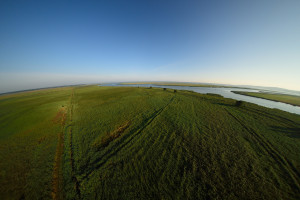Funded through the Krombacher Brewery Species Conservation Project, the Oder Delta team has started to work on improving the breeding and feeding habitats of the lesser spotted eagle. The work started this spring is a great example of how a company can support nature conservation and rewilding.

Earlier this year, Rewilding Europe’s partner organization in the German part of the Oder Delta, the Deutsche Umwelthilfe e.V. (DUH), teamed up with the Krombacher Brewery Species Conservation Project. This well-known German brewery awarded over Euro 800,000 to three DUH-initiated conservation projects of which two are located in the Oder Delta rewilding area. Rewilding Europe and DUH are very grateful to Krombacher for recognizing the value of our work in the Oder Delta and supporting these initiatives.
The first project is focusing on tools and methods of creating a more sustainable fishery management in both the Polish and German part of the delta. The second project aims to protect and enhance the breeding and feeding habitats of the lesser spotted eagle. Both projects will run for 2 years, until end 2017.

During the first phase of the lesser spotted eagle project, the rewilding team completed an analysis of the potential feeding habitats of this beautiful small eagle species in parts of West Pomerania, including Ueckermünder Heath, in Germany. The researchers focused on already known nesting sites and the adjacent open areas, small wetlands and open patches of riparian forests . There are 17 known nesting sites in the examined area that belong to 7-8 lesser spotted eagle territories. The aim is to improve the land and water conditions to secure enough food for the lesser spotted eagle. Good feeding conditions, especially during the breeding season, are a critical factor for breeding success and chick survival.
The breeding distribution of the lesser spotted eagle in Europe covers Eastern, Central and South-Eastern Europe. In Germany it is one of the rarest breeding bird species with only about 100 breeding pairs left in the northeastern part of the country, most of them in the Oder Delta rewilding area and direct surroundings. In September, most birds leave their breeding grounds and migrate through Central and Eastern Europe to their wintering grounds in South-Eastern Africa, to return again in April.

Besides threats during their migration, the species’ population is decreasing due to loss in breeding and feeding habitats. In particular, wet grasslands, wetlands and open forest patches are important feeding places. Unlike most other eagle species in Europe, the lesser spotted eagle hunts by walking and chasing for small mammals, reptiles and amphibians in such habitats. Lesser spotted eagle pairs often build more than one nest in forested areas, using the different nests over the years. This implies the need to conserve larger forest habitats with sufficiently old tree stands. Exactly this combination of diverse habitats is under pressure because of intensive agricultural practices that turn such wet grasslands, wetlands and open forest patches into large areas of croplands.
The northern parts of the Oder Delta have the best potential for lesser spotted eagle habitat restoration actions. Here, minor changes in land management could enlarge the diversity of the feeding habitat. The project team will discuss opportunities of shifting towards such positive habitat management with the relevant landowners and stakeholders. Amongst others, this approach includes the re-wetting of small wetlands and peatlands within the forest areas where most breeding sites are located. When and if we reach such agreements the activities can be included in existing German agricultural and environmental policy schemes.
